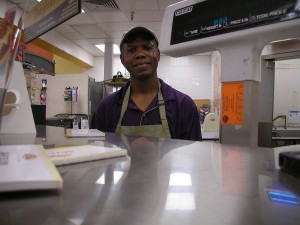
John “JB” Brown is the Assistant Deli Manager at SweetBay, but more importantly, he’s a single father of three.
John “JB” Brown learned everything he knows about being a parent from his mother. That’s a good thing, too, because over the past eight years, the 51-year-old Sarasota native has had a lot of parenting to do on his own.
As he thinly slices spice-laden Cajun chicken breast and honey maple ham at the Deli Counter of SweetBay Supermarket on 34th St., Brown – a single parent of three – can’t help but reflect on the bond he shared with her.
“My mother was a nurse over at Shands, but no matter what, there never was a time my mother wasn’t at one of my games, so I didn’t care about anyone else.”
Growing up in Gainesville, Brown excelled at football at Eastside High School, but the three-sport athlete played baseball and basketball, too. Though his strongest affinity was between the hashmarks on a football field, Brown was determined to balance all three evenly, a trait he must have picked up from his mother.
“My mom was one of those strong women. She kept two jobs, was going to school to be a nurse, all at the same time while we were coming up. And she made it. Became an RN while we were still in school.”
Berthenia King showed her five children where hard work and determination could get you. Despite a demanding schedule, she remained a positive influence on her children, passing on a lot more than just determination.
“She’s why I’m in the kitchen, I love the kitchen,” says the Assistant Deli Manager over the low reverberating hum of the deli counter slicer. “That’s why I’m here… because of her. I was the youngest, so she always had me around when she was cooking, and I picked up a lot of what I know from her.”
He stops slicing and shrugs; as the spinning blade slows, the slightest, saddest smile traces across his face.
“She just passed away man, this past May. 76 years old. Still tears me up sometimes.”
At 51, Brown is a single parent raising three young children. Christian is seven, Cassidy four, and Chandler, his youngest, is three. Both Christian and Cassidy are in school at Wiles Elementary, and Chandler isn’t far behind them.
“A man’s gotta be a part of his child’s life,” he states, turning his attention to the Swiss cheese. “That’s what I love most about it, I get to make a real impact in their life. They get to grow up with some real values and strength about things. I don’t run it like a military school. I buy them whatever they want, but they earn it. I wouldn’t trade ‘em for the world.”
But raising three kids at 51 must be difficult.
He just shakes his head.
“Like I said, wouldn’t trade ‘em for the world.”
He says he provides now easily, but it wasn’t always as easy.
Until stumbling on this job back in April, Brown had been without steady work for nearly three years. There were odd jobs here-and-there, but since the Hospital had fired him for being unable to make his hours (“I couldn’t always be there when they scheduled me, couldn’t just leave the kids.”), the money wasn’t stable. But through the struggle, he never lost the hardened determination that had once made his mother so successful.
“I wouldn’t trade it for the world. Wouldn’t trade none of it for the world.”
These days though? It’s a different story. SweetBay understands his situation, he says. They’re flexible with his hours, he says. And while having a consistent income is a relief, it’s the consistent time he can spend with his children that gives him the most pleasure.
“And the thing I love the most, I can really see it, my eight year old, when we’re driving in the car, he’ll tell the other kids: ‘Hey put your seatbelt on, you’re gonna get my Daddy a ticket. The same thing I used to tell him. I hear him doing it, and I smile to myself, cause he’s serious.”
Just as he still sees some of Berthenia King in himself, he sees some of himself in his children.
With any luck, they’ll get his family values too.










